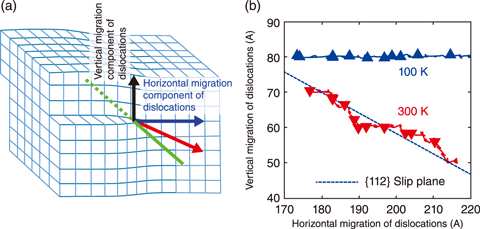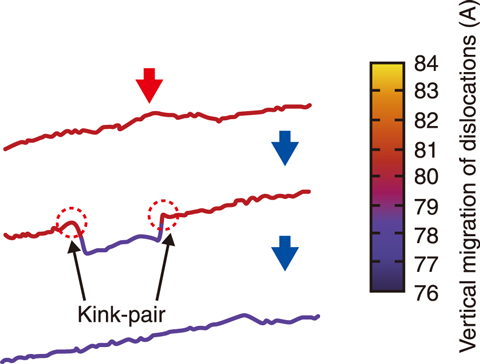
Fig.9-5 Migration of screw dislocations due to iron crystal slip

Fig.9-6 Atomistic simulation of the temporal development of screw dislocations in an iron crystal (blue arrow indicates the time change)
Deformation in metals is categorized into two types: elastic and plastic deformations. In the case of elastic deformation, the deformation is restored when the force applied to the metal disappears. In the case of plastic deformation, the crystal plane slips and the deformation is never restored. Iron is known to be brittle at low temperatures; this is because plastic deformation is less likely to occur. The plastic deformation of iron at low temperatures occurs mainly by the motion of screw dislocations along the slip-plane, as shown in Fig.9-5(a). The high activation energy of the movement of screw dislocations causes the low likelihood of plastic deformation of iron at low temperatures.
The slip-plane of iron can be obtained by quantum mechanical calculation, and the result agrees with the experimental result at low temperatures. However, the slip-plane is known to deviate from the theoretical value as the temperature is raised to room temperature. At low temperatures, screw dislocations travel horizontally, as shown by the blue arrow in Fig.9-5(a); as the temperature increases, the direction changes, as indicated by the red arrow. Despite the ubiquitous nature of iron, the mechanism of this phenomenon is not yet understood. Therefore, atomistic simulations were performed using a supercomputer to clarify this phenomenon.
The simulation results accurately reproduced the experimental data; as shown in Fig.9-5(b), at 100 K, the screw dislocations proceeded horizontally, whereas they proceeded obliquely along the{112}plane at 300 K. On average, the dislocation position moved to the lower layer once every two times. This type of slip, called cross slip, is the cause of the vertical migration component of dislocations observed at high temperatures and occurs due to the increase in lattice vibration by the temperature rise. A detailed investigation of the cross slip indicated that only the short part of the dislocation moves to another layer due to fluctuations, as shown in Fig.9-6; this motion then triggers the movement of the entire screw dislocation to this layer.
These results may aid in the understanding of the mechanical properties of aging nuclear material, which becomes brittle with use.
This study is the result of joint research with the University of Fukui conducted on “The research of interaction between irradiation defects and dislocation for evaluating mechanical degradation of nuclear structural materials”, supported by the Japan Society for the Promotion of Science (JSPS) KAKENHI Grant-in-Aid for Scientific Research (C) (No.26420865).
(Tomoaki Suzudo)